6 Medical Reasons for Changes to Your Nipples
Blog
Introduction
Welcome to Benjamin Shettell, MD - your trusted healthcare professional specializing in skin, hair, and nails. In this comprehensive guide, we will discuss the six medical reasons that can cause changes to your nipples. Understanding these reasons can help you identify potential concerns and seek the appropriate medical attention when necessary.
Hormonal Fluctuations
One of the most common reasons for changes to your nipples is hormonal fluctuations. Hormones, such as estrogen and progesterone, play a vital role in breast development and maintaining nipple health. During puberty, pregnancy, and menopause, these hormonal changes can lead to nipple swelling, tenderness, and changes in color.
Infections
Nipple infections can occur due to various causes, including bacterial or fungal growth. Conditions such as mastitis, a breast infection often seen in breastfeeding women, can cause redness, warmth, pain, and discharge from the nipples. It is essential to seek prompt medical attention for proper diagnosis and treatment to prevent complications.
Inflammatory Breast Cancer
Inflammatory breast cancer is a rare but aggressive type of breast cancer that may cause changes in the appearance of the nipple. Symptoms may include redness, swelling, dimpling, and nipple inversion. If you notice such changes, it is crucial to consult a healthcare professional for further evaluation and breast cancer screening.
Pagets Disease
Paget's disease of the nipple is a rare form of breast cancer that affects the skin of the nipple and areola. It often presents with symptoms such as itching, scaly or flaky skin, nipple eczema, and nipple discharge. Early detection through regular breast self-exams and mammograms is vital for successful treatment.
Fibrocystic Breast Changes
Fibrocystic breast changes are a common condition characterized by lumps, pain, and tenderness in the breasts. These changes can also affect the nipples, causing them to become more sensitive, itchy, or develop a thickened texture. While fibrocystic breast changes are often benign, it is crucial to have any new or persistent symptoms evaluated by a healthcare professional.
Pregnancy and Breastfeeding
Pregnancy and the subsequent breastfeeding period can bring significant changes to your breasts and nipples. Increased blood flow, hormonal fluctuations, and milk production can lead to nipple enlargement, darkening, sensitivity, and even small cracks or soreness. If you experience severe pain, prolonged nipple damage, or signs of infection during breastfeeding, consult a healthcare professional for support and guidance.
Conclusion
Understanding the various medical reasons for changes to your nipples is essential for maintaining optimal breast health. If you notice any unusual or concerning changes, it is crucial to seek professional medical advice promptly. Benjamin Shettell, MD, is here to provide expert care and guidance for all your skin, hair, and nails related concerns. Contact us today for a consultation and get the care you deserve.










